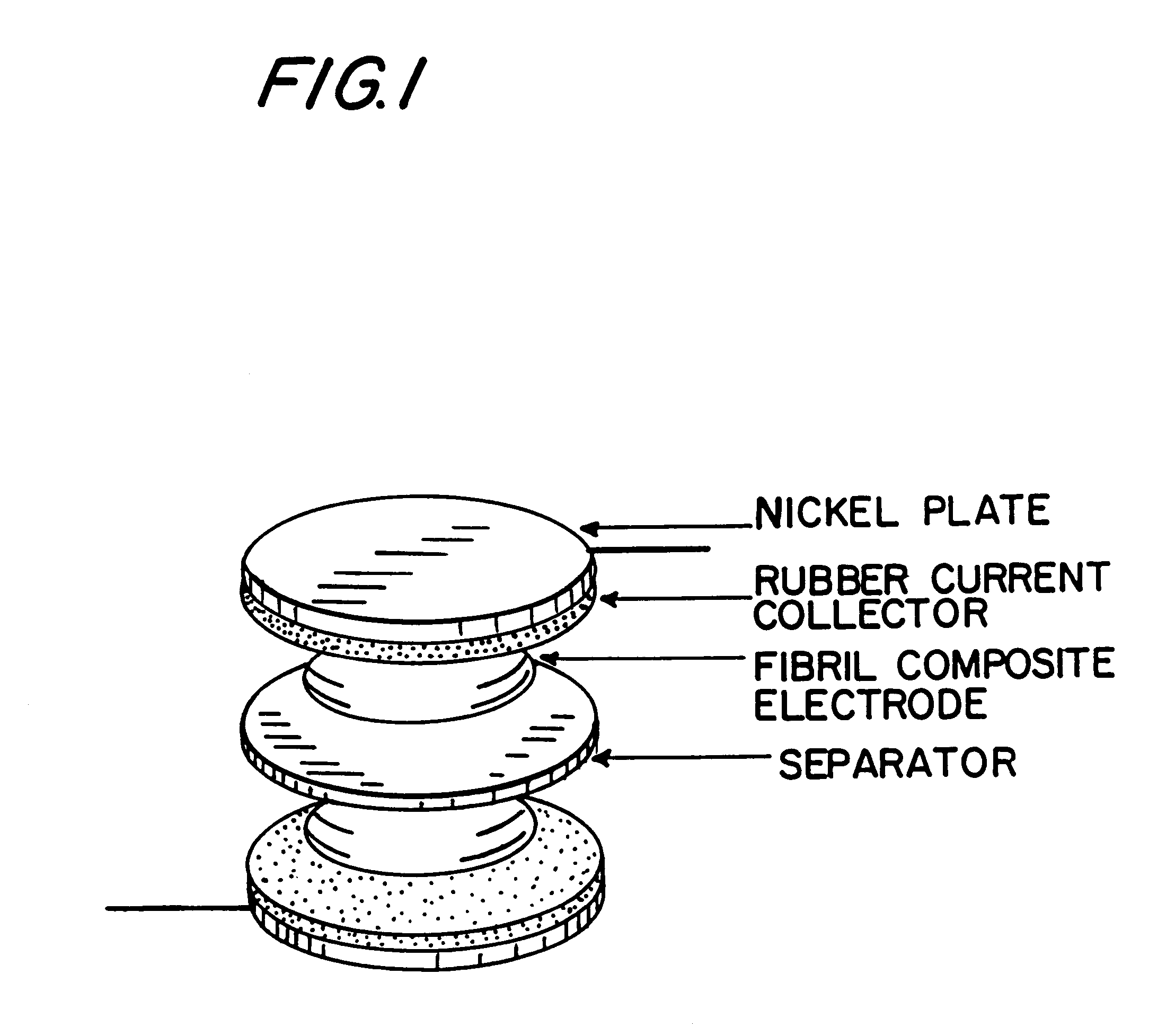Fibril composite electrode for electrochemical capacitors
a technology of electrochemical capacitors and composite electrodes, which is applied in the direction of electrolytic capacitors, electrolysis components, electrolysis processes, etc., can solve the problems of high material cost and low cell voltage of pseudocapacitors, high cost of metal oxide capacitors, and many of the preferred metals, such as ru and ir, to achieve the effect of being highly dispersible in polar solvents
- Summary
- Abstract
- Description
- Claims
- Application Information
AI Technical Summary
Benefits of technology
Problems solved by technology
Method used
Image
Examples
example 1
FIBRIL-R.sub.u O.sub.2 xH.sub.2 O Composite Electrodes
The electrodes were prepared by a sol-gel method, 15 mg of RuCl.sub.3 xH.sub.2 O (Aldrich, used as received) was dissolved in 10 cc water. 50 mg oxidized Hyperion carbon nanofibers were dispersed into 100 cc water. The solution of RuCl.sub.3 xH.sub.2 O was added drop by drop to the fibril dispersion as it was stirred rigorously. A 0.1 M NaOH solution was added to the RuCl3xH.sub.2 O / fibril dispersion until pH of 7 was achieved. The dispersion was filtered and washed until a mat with the diameter of 1.5" was obtained. After heating at 170.degree. C. in air for 12 hours, the mat was tested as an electrode for electrochemical capacitors.
Two electrodes with weights of 5.31 and 5.32 mg, and diameters of 0.5" were prepared from the mat. A single cell electrochemical capacitor was fabricated with these electrode separated by a 0.001" thick polymer separator using 38% H.sub.2 SO.sub.4 as the electrolyte. The specific capacitance for the ...
example 2
Fibril-Activated Carbon Composite Electrodes
Activated carbon (SN-20) obtained from Westvaco corporation was treated with 60% nitric acid to remove inorganic impurities. 0.267 g acid washed activated carbon was ground with a marble agitate mortar for 15 minutes. A composite electrode with the ratio of activated carbon to fibrils of 2 / 1 was prepared by following steps. 0.267 g acid-washed activated carbon and 0.133 g oxidized Hyperion CC fibrils were each separately dispersed in 150 cc water. 5 drops of Triton-100 was then added to the activated carbon dispersion. The two dispersions were then mixed together. After sonication for 5 minutes with a 500 w ultrasound dispenser, the mixture was filtered, and washed, to yield a 3.5" diameter mat. The mat was heated at 350.degree. C. in air for 4 hours.
Electrodes with ratios of activated carbon to fibrils of 1 / 1 and 1 / 3 were also prepared by the same procedure.
The electrodes were characterized by SEM. As shown in FIG. 1, the activated carbon...
example 3
Fibril-Activated Carbon Composite Electrodes
10 g of Hyperion CC fibrils and 20 g acid-washed Nuchar SN-20 (Westvaco were mixed using a ball mill. A 3.5" diameter mat was made by dispersing 0.15 g of a mixture of fibrils and activated carbon in 100 cc H.sub.2 O and then filtering, drying the filtered mat at 120.degree. C. and finally heating the mat at 350.degree. C. in air. The mat had a thickness of 0.0019", a density of 0.58 g / cc and a specific capacitance of 139.4 F / g. The results are summarized in Table I, Book log: 211-72-1.
PUM
| Property | Measurement | Unit |
|---|---|---|
| Length | aaaaa | aaaaa |
| Diameter | aaaaa | aaaaa |
| Time | aaaaa | aaaaa |
Abstract
Description
Claims
Application Information
 Login to View More
Login to View More - R&D
- Intellectual Property
- Life Sciences
- Materials
- Tech Scout
- Unparalleled Data Quality
- Higher Quality Content
- 60% Fewer Hallucinations
Browse by: Latest US Patents, China's latest patents, Technical Efficacy Thesaurus, Application Domain, Technology Topic, Popular Technical Reports.
© 2025 PatSnap. All rights reserved.Legal|Privacy policy|Modern Slavery Act Transparency Statement|Sitemap|About US| Contact US: help@patsnap.com



